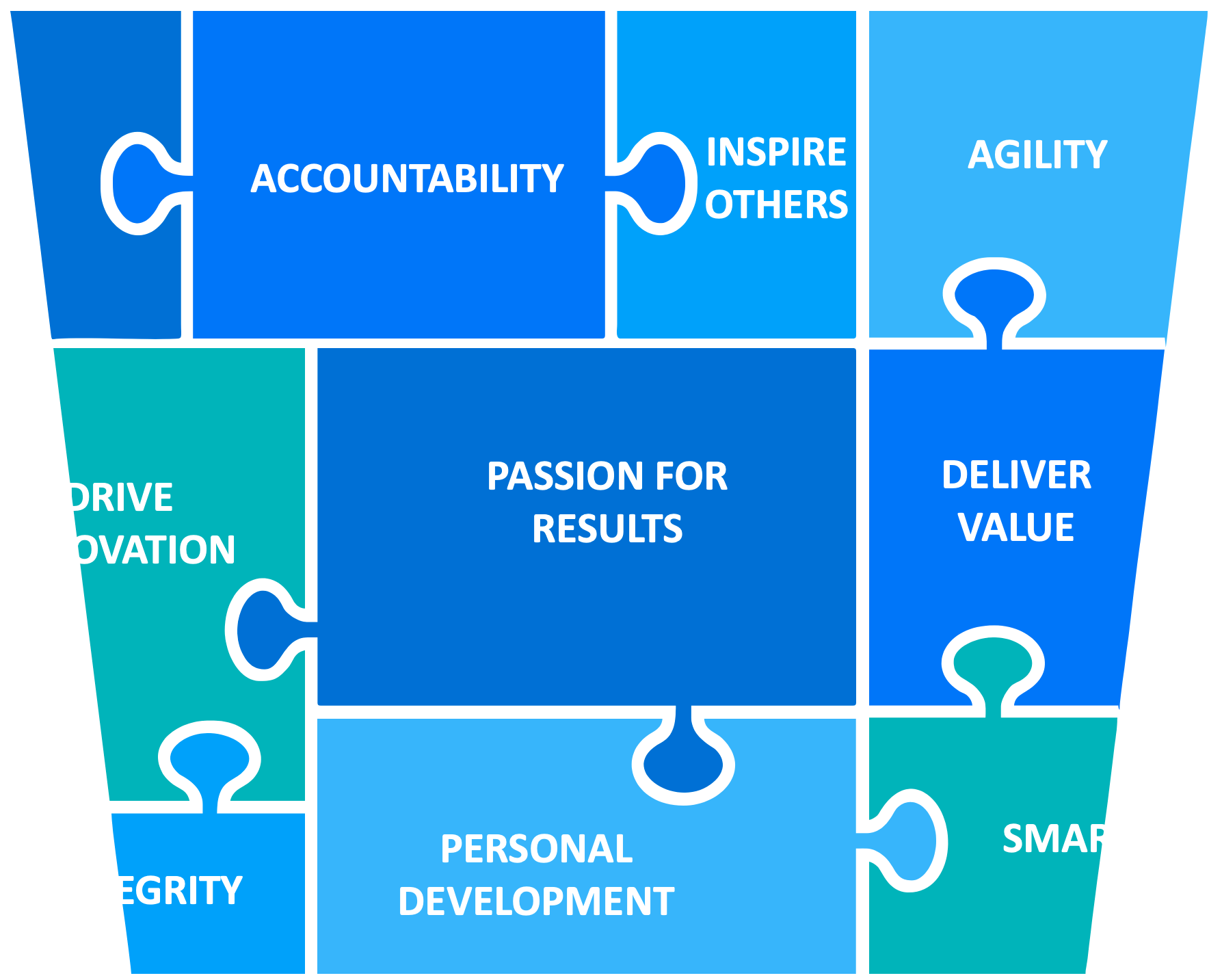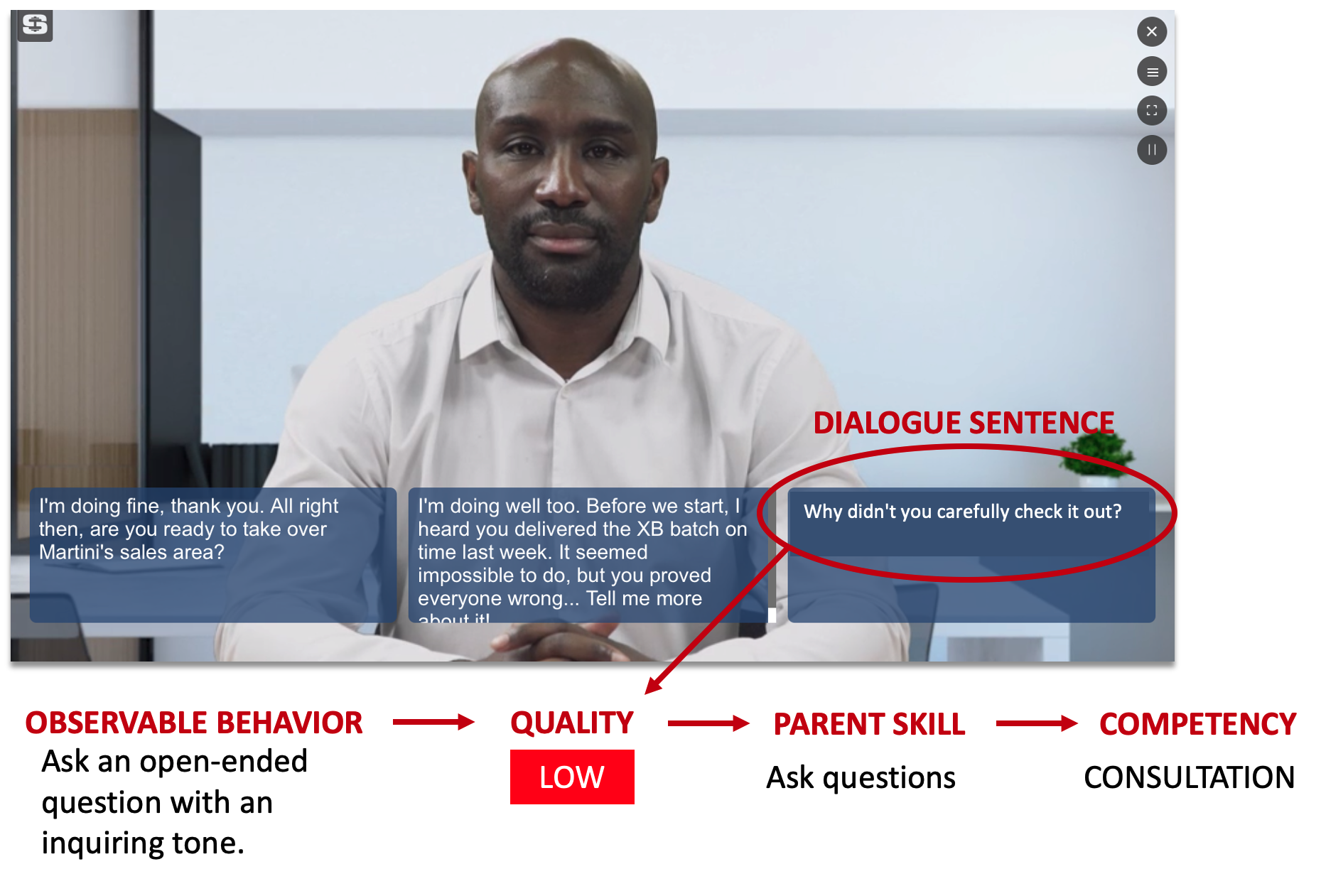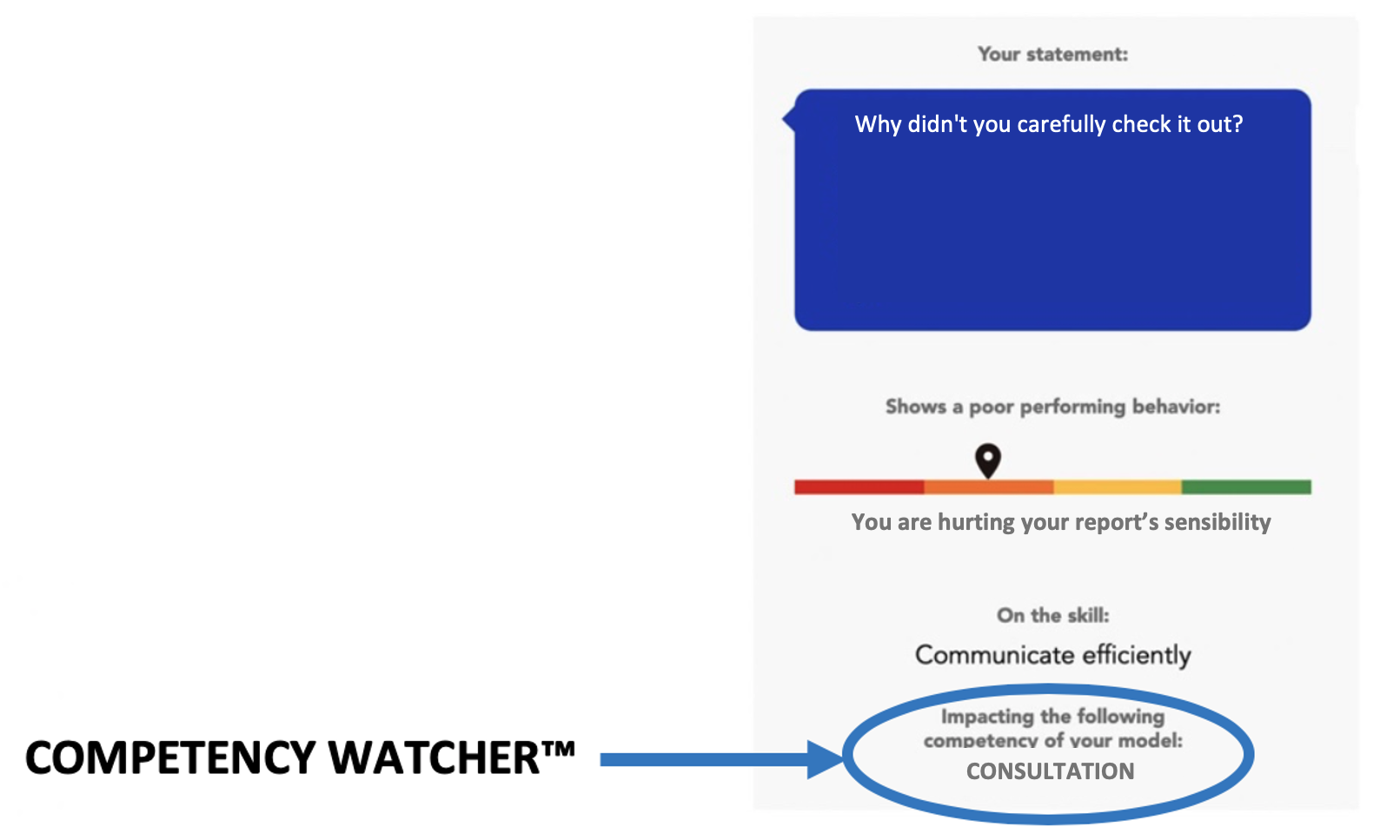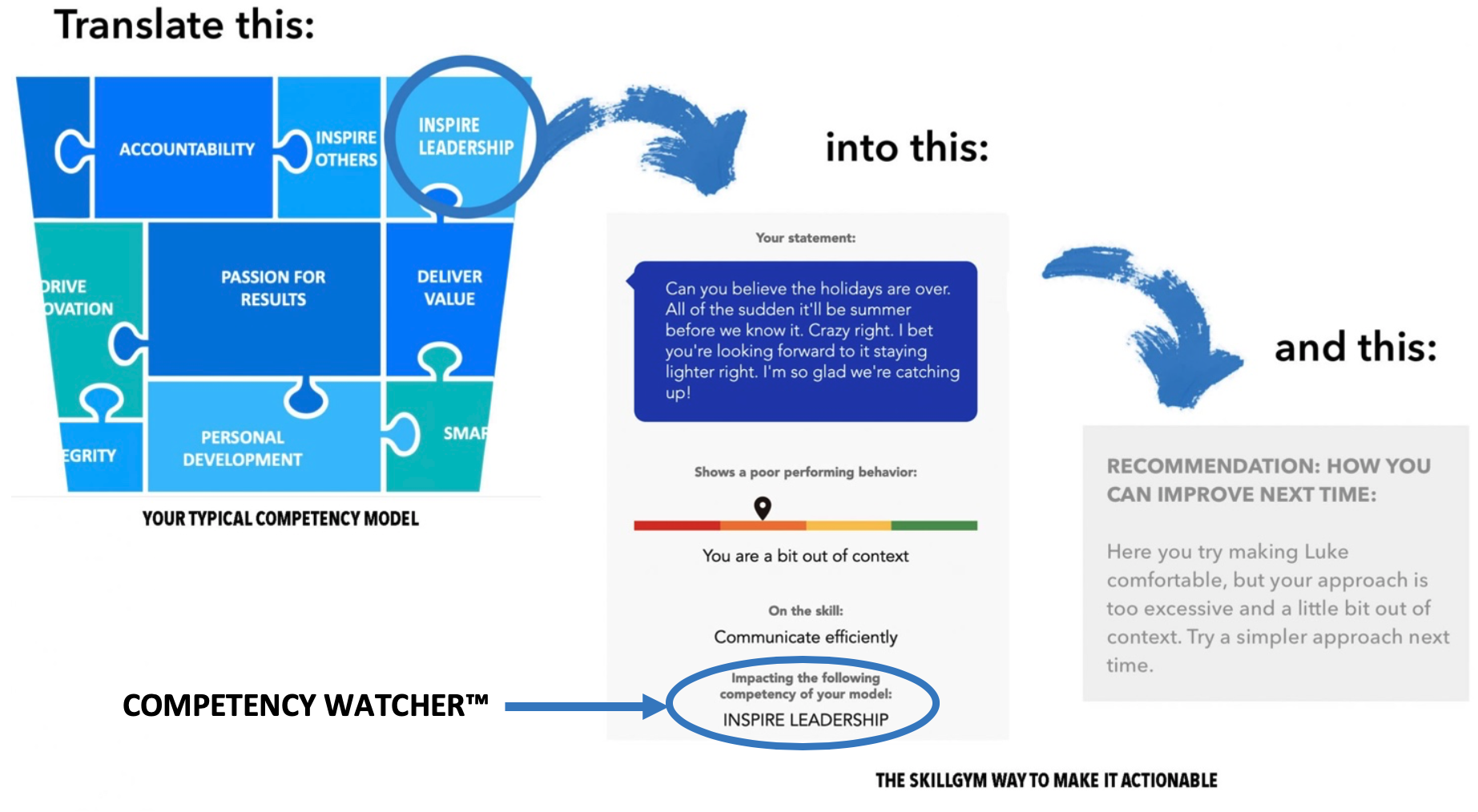
Competency and Capability models are very popular these days: a guideline developed to set out the specific skills, knowledge and behavioral requirements that enable an employee to perform their job successfully.
Leadership competencies in particular are often outlined for supervisory and management related roles, however, they can be applied to any job position that requires an employee to lead others.
They normally look like this :
Generally speaking, a well-designed leadership competency model provides specific behaviors that an employee must apply on the job in order to be successful.
On one side, such models should enable HR and Training to more accurately identify learning & development (L&D) needs and, on the flip side, it should allow employees to take ownership of the skills and behaviors required of them in their roles and to support others.
It’s no surprise that, in a competency survey by the Society for Human Resource Management (SHRM), 93% of 500 C-suite executives claimed that competency models were important to their organization’s performance success.
Why competency models work well for companies, but not so well for employees?
Worldwide and especially in the U.S., organizations spend enormous amounts of money on employee training and education, but unfortunately, they are not always getting a good return on their investment.
For the most part, the learning doesn’t lead to better organizational performance, because people soon revert to their old ways of doing things.
This is why many organizations are increasingly questioning the value of their existing competency models—at least in terms of real applicability in the field.
Here is what one of our clients recently told us:
“Our competency model is beautiful, but hard to apply. Despite all our training efforts, it has not been well embedded in the organization. Most of our leaders either are not familiar with the model or do not use it at all. They tell us that it is too complex and theoretical. They are not able to connect it to their daily behaviors.”
This is not surprising. Most competency models built and implemented these days are very complex to integrate into daily life. Unfortunately, if you can’t connect a theoretical competency to your daily behaviors, chances are you will not recognize your mistakes and, even worse, you won’t be able to turn daily experience into lessons learned.
The main cause of this explosion in numbers is due to building the model around multiple levels of competencies (e.g., enterprise level, functional level, leadership level) as well as multiple levels of proficiencies (e.g., Excel, Solid, Development).
So why are such models failing? Isn’t being comprehensive a good thing to ensure the models cover every single capability required for success?
Based on feedback from our clients, we see a couple of key reasons.
1) PEOPLE HATE COMPLEXITY
First of all, leaders and employees dislike working with large, dense and complex competency models. For them, work life is complicated enough. As users, they find models difficult to comprehend.
What they want is clear guidelines about what is good and what is bad in their daily lives and, clearly, in their conversations.
We couldn’t agree more. We believe that balancing comprehensiveness with practicality is the secret to maximizing the level of buy-in from employees.
Try to think of a sufficiently abstract competency such as “Consultation“. Of course, analyzing it from a conceptual point of view and referring to what a good model could provide as a description, its meaning and its importance are clear to anyone.
Here is how it could be described: “The ability to provide guidance to organizational stakeholders.”
And if we then go into the behaviors that this competency requires to be demonstrated, here is an equally clear list:
- Applies creative problem-solving to address business needs and issues
- Serves as an in-house workforce and people management expert
- Analyzes specific business challenges involving the workforce and offers solutions based upon best practice or research
- Generates specific organizational interventions (e.g., culture change, change management, restructuring, training, etc.) to support organizational objectives
- Develops consultative and coaching skills
- Guides employees regarding specific career situations
Wow, simple isn’t it?
Unfortunately, not!
Because it’s one thing to understand well what a behavior such as “Guides employees regarding specific career situations” means.
It’s another thing, and quite different, to be able to trace this behavior to specific daily actions with the clarity that allows anyone to recognize these actions while they are being carried out.
Considering then that most of the leadership behaviors take place in conversations, it is a matter of being able to transform that observable behavior into ways of conducting a conversation, and therefore into empowering rather than weakening pieces of dialogue.
Here the matter gets complicated and unfortunately, this is only the first half of the problem. Here is the second.
2) PEOPLE DON’T CHANGE JUST BECAUSE THEY KNOW HOW-TO
Second, but not less important, daily behaviors are deeply rooted into habits that were developed over decades.
So even when employees find the energy to fully understand the applicability of the model, they are still hard-wired to unconscious patterns of behaviors that keep them doing the “good old things” even if they really want to change.
We know very well what effort is needed to change a behavior (I talked about this subject quite extensively in this article “From Critical to Empowering Conversations: Practicing Increases Self-Confidence“) and therefore it should be clear that, even if we were able to “translate” competencies and related behavior into conversational best practices that are easy for anyone to understand, we would still be very far from the goal of transforming this knowledge (or even this “awareness to cognitive level”) in a real habit, consolidated and truly automatic.
How people really change
Before presenting the way SkillGym can help your organization to bridge the gap between your Competency model and your leaders’ daily conversational behaviors, there are a couple of things to detail about the way we build our simulations and the way our training methodology works:
- The way competency models are normally built and their relationship with skills, behaviors and conversations
- The way Digital Role Plays work in terms of turning an interactive conversation into powerful feedback and, from there, into real and actionable experience
If you are not familiar with these two aspects, I highly recommend reading these two articles before moving on:
- The first article, “Making a Competency Model Truly Actionable in People’s Development”, describes how a well-designed competency model can be the starting point of actionable and effective learning strategies for people’s and leadership’s development. This is great reading to understand the structure of our simulations in terms of how dialogues of a conversation are reconnected to observable behavior and then grouped into skills and competencies.
- The second article, “8 Ways Your Skills Will Improve by Practicing on Digital Role Plays“, delves deep into the eight triggers that turn practice-based learning into rock-solid experience. Of course, consistent practice backed up by these triggers is the best way to break the habits that most often keep us away from applying the right behaviors.
As we said, the secret to success of any competency model, which is not just an infographic piece of paper hanging on the wall, is to build a bridge that allows those who train to immediately reconnect their behaviors to the skills model. In fact, the change occurs in two phases:
PHASE 1: UNDERSTANDING
Initially, we need to make it easier to understand the connection between a sentence said within a conversation, the related and underlying observable behavior and the competency of the model to which it refers.
A very simple example would be the following. Let’s imagine one leader asking the following question about his report during a conversation where he is evaluating the results of a certain project: “Why didn’t you carefully check it out?”.
Now, let’s imagine the same leader being able, in real time, to reconnect such sentence:
- Dialogue sentence: “Why didn’t you carefully check it out?”
To the following behavior:
- Observable Behavior: Ask an open-ended question with an inquiring tone
And also to rate that behavior as follows:
- Quality of observable behavior: Low
And, of course, recalling that such behavior not only generates from the following skill (that he should be aware of being responsible to train and improve):
- Skills to which the behavior is attributable: Ask questions
And, finally and most importantly, that this sentence has a clear impact on the following competency belonging to the corporate leadership model to which he should comply:
- Competency of the model to which this skill belongs: Consultation
Not easy, right?
Now, if on the one hand it could be quite simple (at least most of the times) to connect the sentence itself to the observable behavior and therefore to the skill, it may be less obvious to relate it to the competency (here I have inserted a fairly common managerial competency as an example, but you can do the exercise yourself by imagining any of those from your model).
However, truth is that none of us (even imagining that we are able to connect the dots in such a lucid way) is able to do this exercise, constantly and in real time, for each sentence we say.
That would be the only way to make sure that, day after day, leaders in our organization adjust their daily conversational behaviors according to what our competency model recommends that they do.
PHASE 2: EXPERIENCING
In the meantime, to be truly effective, the impact of that sentence, of that behavior and, therefore, of that competency, should be provided in the form of an empathetic reaction by the counterpart.
The user receiving the effect of their action in real time, through the response (verbal, para-verbal and non-verbal) of the other party.
This would allow them to move beyond the simple (and volatile) understanding of the logical connection between a certain action and the reference model; but, more importantly, to EXPERIENCE the impact that a bad application of the model has on everyday relationships, by witnessing through emotion the effect of their own wording.
The important point here, therefore, is not so much the ability to map a competency model on observable daily behaviors. This is something you’ve probably already done.
Except that, on average, the destination of this exercise is a document, a presentation, a webinar or an infographic to hang on the wall.
You know too well that this cognitive contribution—although at the beginning it helps to better understand the relationships between models and behaviors—does not really manage to deeply impact people’s behaviors.
Bridging the gap
Ok, let’s see how SkillGym can help you in the process of transforming your leaders’ behaviors to align them with the guidelines of your leadership model.
If you are familiar with SkillGym, you should know that the Augmented Replay is the most effective way of translating the patterns of behavior that are important for great leadership into daily life conversations (read this article to know more about Augmented Replay if you haven’t ever tried it first-hand: “Making a Competency Model Truly Actionable in People’s Development“).
The way our Competency Bridging service works is very simple, yet still very powerful:
- We map, once and for each simulation, your proprietary competency model to the skills that are trained in each individual simulator of our libraries
- During training, the newly released SkillGym’s Augmented Replay 2.0 Competency Watcher™feature shows this relationship, explicitly and for each sentence that was used within the dialogue.
SkillGym already maps over 50 different skills belonging to the domain of conversational leadership such as those listed for each of our powerful training programs.
Of course, one single simulation alone does not cover all those skills. It typically lets the trainee practice on seven to ten conversational skills.
However, when trainees are facing a training boot camp that includes a full program of four or eight simulations… well, most of those skills get covered and that’s when the activation of a premium component such as the Competency Watcher ™ can really make the difference.
The connection between a piece of the dialogue with its underlying behavior is already an eye opener.
Adding a qualitative and quantitative rating to it allows trainees to recognize the weight of their words. And this is what you would normally expect from Augmented Replay.
When we add the Competency Watcher™component, all this gets connected to your leadership model.
It is like saying to the trainee: “Look, this statement of yours is the result of this behavior, which was not really performing well, by the way…and this affects your business performance since it is linked to this competency of our model. Next time you know what you should avoid saying in this circumstance.”
For every single sentence of the conversation!
Putting it into graphic format, this picture shows very well what you can achieve with our Competency Bridging service:
What really makes the difference with this new component when added to the Augmented Replay 2.0 is that the trainee is fed with continuous, dynamic and contextualized feedback that:
- On the one hand, allows not only the underlying behaviors, but above all their connection with the reference models that the organization intends to spread within daily sentences;
- On the other hand, it allows the impact that these behaviors (and therefore the application of the model) generated in the reactions of the people with whom you deal daily through conversations to be absorbed both analytically and emotionally.
This mechanism, as extensively explained by neurosciences (please read this article “The Neurosciences Underlying the Models of Digital Role Play” to learn more) is at the core of sustainable and long-term change.
Consistent training is in itself the vehicle for change. Practicing with the help of an advanced real-time competency mapping component such as the Competency Watcher ™ brings the experience to the next level. In each session, it is possible to show trainees in a direct, practical and actionable way how their actions intersect, in a more or less virtuous way, with the behaviors that your organization promotes, making training even more valuable for a wide spread scale of the reference model.
What’s next
If you are searching for the Digital Role Play solution that suits your needs, take a look at our website, which has pre-recorded webinars and articles among other inspiring content for your review.
You are also invited to book a 1-hour discovery call with us if you would like to continue this conversation.
Enjoy the rest of your day.




